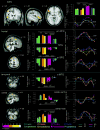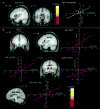Neural correlates of evaluative compared with passive tasting
- PMID: 19614981
- PMCID: PMC2776645
- DOI: 10.1111/j.1460-9568.2009.06819.x
Neural correlates of evaluative compared with passive tasting
Abstract
We used functional magnetic resonance imaging to test the hypothesis that the nature of the neural response to taste varies as a function of the task the subject is asked to perform. Subjects received sweet, sour, salty and tasteless solutions passively and while evaluating stimulus presence, pleasantness and identity. Within the insula and overlying operculum the location of maximal response to taste vs. tasteless varied as a function of task; however, the primary taste cortex (anterior dorsal insula/frontal operculum--AIFO), as well as a more ventral region of anterior insula, responded to taste vs. tasteless irrespective of task. Although the response here did not depend upon task, preferential connectivity between AIFO and the amygdala (bilaterally) was observed when subjects tasted passively compared with when they performed a task. This suggests that information transfer between AIFO and the amygdala is maximal during implicit processing of taste. In contrast, a region of the left lateral orbitofrontal cortex (OFC) responded preferentially to taste and to tasteless when subjects evaluated pleasantness, and was preferentially connected to earlier gustatory relays (caudomedial OFC and AIFO) when a taste was present. This suggests that processing in the lateral OFC organizes the retrieval of gustatory information from earlier relays in the service of computing perceived pleasantness. These findings show that neural encoding of taste varies as a function of task beyond that of the initial cortical representation.
Figures





References
-
- Anderson AK, Christoff K, Stappen I, Panitz D, Ghahremani DG, Glover G, Gabrieli JDE, Sobel N. Dissociated neural representations of intensity and valence in human olfaction. Nat Neurosci. 2003;6:196–202. - PubMed
-
- Barry MA, Gatenby JC, Zeiger JD, Gore JC. Hemispheric dominance of cortical activity evoked by focal electrogustatory stimuli. Chem Senses. 2001;26:471–482. - PubMed
-
- Beckstead RM, Morse JR, Norgren R. The nucleus of the solitary tract in the monkey: projections to the thalamus and brain stem nuclei. J Comp Neurol. 1980;190:259–282. - PubMed
-
- Cerf-Ducastel B, Murphy C. Validation of a stimulation protocol suited to the investigation of odor-taste interactions with fMRI. Physiol & Behav. 2004;81:389–396. - PubMed
Publication types
MeSH terms
Grants and funding
LinkOut - more resources
Full Text Sources

